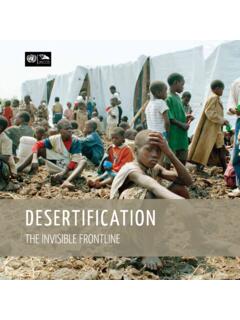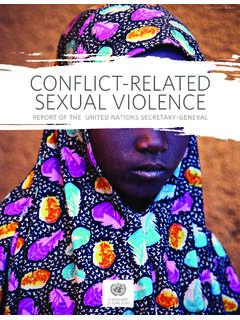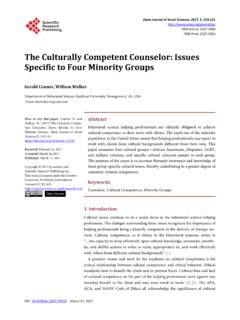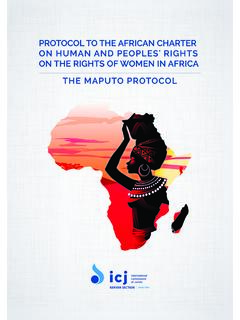Transcription of EDUCATION IN EMERGENCY - Coopi
1 EDUCATION INEMERGENCY policyCameroonPhoto: a. BarrySUmmarYIntroduction 5 The theoretical framework 6 Key definitions The international legal framework for eieCooPI S approach to EDUCATION in EMERGENCY :key concepts and good practices 14 Glossary 22 Bibliography 26acronyms 27 Coordination:Barbara Nese, Head of Research and Programs Innovation elaboration:Laura Pasquero (Protection Advisor)Grateful thanks are due to:Francesca Rivelli who provided a significant contribution to the drafting of this thanks are due to: Marco Loiodice, Alessandro Ponti, Waseem Solangi, Emanuela Cappuccini and the whole team - both headquarters and country office operators - who contributed to carry out this , the elaboration of this policy would have never been possible without the interest and active involvement of Coopi s director, Ennio doCUmenTS of The orGanIzaTIon Policies currently available: Corporate Social Responsibility Childhood Environment and Disaster Risk Reduction Food Security Gender Nutrition Security ProtectionarT dIreCTIon: Gruppo Egeo srlCover PhoTo: Simone DurantereLeaSe daTe: December 2018aUThorS and CredITS5 Coopi - Cooperazione Internazionale is a humanitarian foundation established in 1965.
2 During its more than 50 years of activity, Coopi has worked in 65 countries, involving thousands of local operators and providing a direct benefit to millions of women, men, girls, boys and communities. Its mission is to contribute, through the commitment, motivation, determination and professionalism of its staff to the process of poverty reduction and growth of the communities around the world. Coopi intervenes in EMERGENCY , reconstruction and development contexts in order to achieve a better balance between the North and South of the world, between developed areas and areas in EDUCATION in EMERGENCY (EiE) Policy is part of a series of documents which Coopi is adopting in order to position itself with respect to issues that are central to the work of the organization1. EiE is inscribed in Coopi s overall approach to Protection as outlined in Coopi Protection Policy (2016), Coopi Gender Policy (2015), and Coopi Child Policy (2015).
3 In addition to this policy document, Coopi has developed a practical guidance document ( Coopi s Standard Operating Procedures on Protection - SOPs) which translates the theoretical level into the practical programs level, providing Coopi with operational guidance and a practical policy is broadly led and informed by the approach and key principles of the International Network of EDUCATION in Emergencies (INEE), of which Coopi is a member since 2017, and in particular its core publication INEE Minimum Standards for EDUCATION : Preparedness, Response, s reference programs in EiE have mainly been developed in the Central African Republic (CAR) since 2007 and in Niger since 2015, although several other EiE projects have been carried out in a variety of contexts including Chad, Nigeria, the Democratic Republic of Congo, Ethiopia, Palestine, Lebanon and Iraq with funding mainly provided by UNHCR, UNICEF, ECHO, Common Humanitarian Fund, and the Swiss Cooperation At the time of writing, Coopi has adopted the following Policies: Protection Policy, Child Policy, Gender Policy, Food Security Policy, Nutrition Security Policy, Disaster Risk Reduction & Environment, Corporate Social The 2004 edition of the INEE Minimum Standards handbook is the international reference guidelines for the sector.
4 Coopi archiveIntroductioneie is necessary to survive and save lives at the same time by bringing individuals a physical, psychosocial and cognitive protection and offering the social structure, stability and hope in the future particularly to children and adolescents. Coopi team, Central african republic, 20106edUCaTIon In EMERGENCY (eie) EDUCATION in EMERGENCY (EiE) can be defined as set of project activities that allow structured learning to continue in situations of EMERGENCY , crisis or long-term instability3. The Inter-Agency Network for EDUCATION in EMERGENCY (INEE) describes EiE as quality learning opportunities for all ages in situations of crisis, including early childhood development, primary, secondary, non-formal, technical, vocational, higher and adult EDUCATION providing physical, psychosocial and cognitive protection that can sustain and save lives 4.
5 EDUCATION s life-sustaining and life-saving role has been acknowledged and the inclusion of EDUCATION within humanitarian response is now considered crucial. In the short term, EDUCATION is important in meeting children s and communities basic needs, while in the long term it helps them to reduce their vulnerability and will equip them with the necessary tools to build their (new) roLe of eie In ConfLICT and CrISIS SITUaTIonSEducation system often breaks down or is significantly disrupted in EMERGENCY situations. While school infrastructures and teaching staff can be severely affected, security issues and risks, including active fighting, presence of armed actors (and/or of landmines), may make going to school a dangerous activity and prevent children, more often girls, from attending schools.
6 During emergencies, the increased exposure to security risks and violence including gender-based violence (GBV) add to other pre-existing forms of GBV and of inequality that are rooted in unequal gender normativity and power imbalances. By providing a safe learning environment that can protect both a child s body and mind, EiE interventions have the power to mitigate the psychosocial impact of conflict and disasters by providing learners a sense of routine, stability, structure and hope for the future. In addition, EDUCATION can convey life-saving information to strengthen survival skills and coping mechanisms, for example though information and awareness on hygiene practices, prevention of sexually-transmitted infections (including HIV), sexual and reproductive health, GBV risks and prevention, peaceful communication and resolution of conflicts , landmine safety and so on.
7 Moreover, quality educations interventions help reduce the risk of violent conflict by enhancing social cohesion, supporting conflict resolution and peace-building skills among learners, teachers and the wider Save the Children, EDUCATION in Emergencies Toolkit, INEE, Minimum Standards for EDUCATION : Preparedness, Response, Recovery, 2012. 5 Further background on the theoretical framework for Child protection can be found in Coopi Child theoretical framework Key definitionsrCaPhoto: Coopi archive7 Good practicesCommUnITY enGaGemenTIn different countries, like the Central African Republic (CAR), Coopi supports the creation or revitalisation of School Committees towards autonomy and self-sufficiency in managing school infrastructures. Sometimes, like in Haut Mbomou in 2011, Committees are also encouraged in engaging in income-generating activities that can support educational services and teachers compensation.
8 The involvement of local community leaders is an important part of Coopi interventions towards local ownership. The formative meetings with the various government and religious authorities present in the city of Obo allowed them to feel the drivers in the construction of the school system: to make the EDUCATION system work well everyone has to be motivated to take part in the development of the process. ( Coopi Final report, OBO, CAR, June 2010).nIGerPhoto: Simone duranteThe TheoreTICaL frameWorK8 The LInKS BeTWeen EDUCATION and ProTeCTIon EDUCATION can play a critical role in strengthening children s protective environment, including for vulnerable individuals and groups such as girls, children living with disabilities, children from ethnic or linguistic minority communities, Unaccompanied and Separated Children (UASC), or Children associated with armed forces and armed groups (CAAFAG).
9 This is particularly important when the EMERGENCY increases children s vulnerability. Within the safe classroom learning environment, teachers and peers can easily oversee children who may be particularly exposed to specific risks and intervene to support and protect them. The availability of a protective environment where teachers are able to identify protection risks issues, including GBV, and acting upon them in a child-centered safe and confidential way through referral systems for access to care is therefore key. In this sense, schools and learning spaces can act as a key entry point for the provision of essential support beyond the EDUCATION sector such as protection, health, nutrition, and water and sanitation services. EDUCATION affect positively WASH interventions, as a matter of fact it enhances behavior change in double way: on the one side thanks to a child to child learning approach and the other side children can transfer what they have learnt at school in their respective communities such as open provision of psychosocial support, in different ways and with different approaches, to all children and youth in schools and communities is a vital component of EiE interventions both as part of schools activities and of teacher s training.
10 Psychosocial support to children and youth in emergencies as part of an EiE intervention requires an integrated approach which addresses children s survival and protection needs while emphasising the importance of family, community and local cultural beliefs/traditions in helping children to cope with the impact of the : Simone duranteThe TheoreTICaL frameWorK9 Good practicesdIaP and dIaP-ado In nIGerEiE interventions in Niger have been focusing on responding to EDUCATION and protection needs of refugees, IDPs and host populations, in particular, on Unaccompanied and Separated Children (UASC), GBV survivors and other vulnerable groups. Since 2014, in the Diffa region, have been set-up and managed mobile safe temporary learning spaces for children and adolescents (DIAP/DIAPado - Dispositifs Itin rants d Aide Psychosocial/Mobile safe learning spaces for children).





